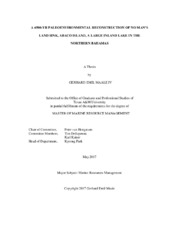| dc.description.abstract | No Man’s Land Sink is one of the largest inland lakes on the Little Bahama Bank in the northern Bahamas, so its paleoenvironmental history may provide insight into how the regional hydroclimate and groundwater systems developed over the Holocene. In its modern state, the site is shallow, brackish (20.6 psu), 170 m in diameter, and located ~700 m from the coastline. Prior to 6400 Cal yrs BP, the accumulation of peat deposits and no aquatic invertebrates (e.g., ostracodes, foraminifera, aquatic mollusks) indicate that the site was a terrestrial ecosystem. However, the site transitioned into a subaqueous freshwater environment at 6400 Cal yrs BP, when the site became palustrine-lacustrine environment until 4200 Cal yrs BP. During this time, widespread palustrine-lacustrine carbonate deposition and the appearance of freshwater to low mesohaline microfossils indicates a likely oligohaline environment in the sinkhole (charophytes, ostracodes: Candona annae, Cypridopsis vidua, foraminifera: Helenina davescottensis, mollusks: Planorbis, Hydrobia). A salinity increase at 4200 Cal yrs BP is inferred from the appearance of the ostracode Cyprideis americana that typically prefers salinities exceeding 10 psu, and deposition of laminated microbial mats. Thereafter, an organic-rich, algal sapropel unit (56.9% bulk organic matter) accumulated that was devoid of any microfossils or mollusks. This unit suggests that the lake hosted a stratified water column, where surface waters supported phytoplankton primary productivity and corrosive or anoxic bottom water conditions hampered microfossil growth or precluded their preservation. The transition to the modern environment (~20 psu) at 2600 cal yrs BP is characterized by diversification of brackish ostracodes (Aurila floridana, Dolerocypria inopinata, and Hemicyprideis setipunctata), foraminifera (Elphidium spp., Ammonia beccarii, Triloculina oblonga) and mollusks (Anomalocardia, Cerithidea). Over the middle to late Holocene, No Man’s Land has experienced abrupt salinity increases that are most likely driven by southern migration of the Intertropical Convergence Zone, hurricane-induced mixing and salinization of the topmost section of the coastal aquifer, and shoreline migration and groundwater-level rise in response to Holocene sea-level rise. | en |


